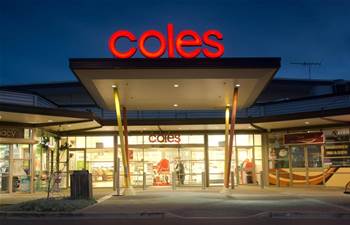Coles is embarking on a four-year transformation it is calling Smart Selling that aims to use technology - coupled with job cuts - to reduce its costs by $1 billion.
CEO Steven Cain said that the transformation would “automate manual tasks and simplify above-store roles to remove duplication”.
He also flagged “extensive use of data analytics and artificial intelligence to ensure we are anticipating and fulfilling customer needs as they continue to evolve”.
The supermarket giant last week brought in Metcash’s transformation head Ian Bowring to front Smart Selling, and cut 450 staff, which Cain told an investor day today signalled the “first phase” of the program.
Bowring’s role is, in part, to “hold people to account to make sure that $1 billion [in cumulative cost out] is delivered over the next four years,” Cain said.
Cain said that Coles “are not gifted amateurs at taking cost out of businesses” and that a “detailed plan on how this will be achieved over the next four years” had been drawn up.
A sizable part of the strategy involves increased technology investments in all parts of Coles’ operations.
Back in February, Coles said it was putting in a new finance, procurement and HR stack by SAP, which Cain said is progressing.
“Our systems aren’t state of the art here. We have spent a lot of time over the last six months working with a number of our technology partners. SAP in particular is going to be providing some new HR, finance and procurement systems, and we’re working with Optus and the [National] Broadband Network to make sure that we’ve got high speed internet access into all of our stores, that’s both supermarkets and liquor,” Cain said.
“That will revolutionise what we can do in-store and the speed at which our team members can access things like training materials and so on.”
Cain also said that Coles had bought a “new system that means we’ll be able to tailor the ranges in stores better than we’ve ever done in the past.”
“At the moment our range and pricing structure is the same across the nation,” he said.
Chief supply chain officer Matt Swindells told the investor day that further technology investments were being made to help break down pallets once they are delivered to a store, and to aid loss prevention.
“We have almost 85,000 team members serving 17 million customers a week and handling 20 million cases from the back door to the shelf,” Swindells said.
“There is a vast amount of unproductive task and manual handling that still sits within that operation, and technology is advancing at such a rate there is an opportunity to remap that model.”
Swindells said that an undisclosed wearable device is being used by back dock workers to “enable the splitting of a load through a much smarter, simpler and pleasant working environment to help start to drive down some of that cost.”
He said that as cost caught up in the “wrong activity” was driven out, that Coles wanted “to then reinvest it in the right activity which is customer-facing and where customers tell us we need to improve our operations.”
Technology is also being targeted at what Swindells called “profit protection” but is really loss prevention.
“A number of our stores now have smart EAS [electronic article surveillance] gates. They’re the barriers you walk through when you enter either the assisted checkout area or you exit the store,” Swindells said.
“We now can enable high risk products to signal to the team member in the assisted checkouts that a customer has entered and probably needs to have a higher level of service and prevent any risk of profit loss, way before we start thinking about whether people have left the building.”
Swindells also said that technology could be used to remove cost from the stocktake process, and to “mitigate the increasing cost headwind of energy”, such as by using LED lighting and fitting more efficient doors to fridges.
The company also said it would bring all its supply chain assets together “to sweat them as hard as possible”.



























